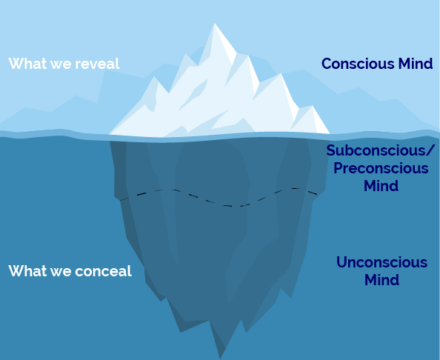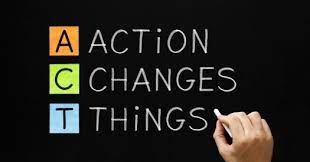
Many influential people and historical figures discovered that their happiness was intertwined with the well-being of others. They knew that creating lasting change meant they had to set collective goals, not just personal ones. Clear, intentional thinking also helped to direct their minds and thus their work.
Take someone like the Buddha who once said, “What you think you become.”
If what we think determines our results, then the secret to success, or achieving any intention, is through our mind and our thoughts
The field of cognitive behavior therapy confirms this idea that our thinking influences who we become. Cognitive-behavioral therapy looks at three different fields; our thoughts, our emotions and feelings, and our actions.
There is a direct correlation between these three fields. What we think, affects how we feel. How we feel, drives all of our actions and therefore, the results we produce.
The Power of Conscious Thinking

Setting intentions is one way we can focus our minds on achieving the results we seek. Part of the mind’s job is to seek out the things we want and need. Very few things cannot be accomplished when we direct our mind toward achieving a goal.
In the yoga tradition, an intention is referred to as a Sankalpa. A Sankalpa is a single sentence that is result-oriented, and aimed at fulfilling a desire. The ancient concept of Sankalpa is based on the idea that our mind has a limitless capacity to create the life we imagine.
An intention is a version of conscious thinking that requires us to direct our thoughts instead of listening to them. Intentional thinking helps us quiet our inner mind chatter and moves us in the direction of who and what we wish to become.
The Pitfalls of Unconscious Thinking

We live in a fast-paced world full of busyness and distractions. All of the stimuli that are a part of our daily lives make it challenging for us to be still.
But stillness matters.
There is power in becoming still. Stillness allows us to observe our thoughts, and connect with our inner creativity, inspiration, and wisdom. One of the purposes of meditation practice is to direct our mind toward stillness and away from the busyness of our thoughts so we can focus on our inner intentions.
But many times our mind engages with the world while on autopilot. An unconscious mind takes over and runs the show. In fact, 80% of our thinking comes from the unconscious mind. This disconnection from our internal environment can lead us further away from specific intentions.
When we unconsciously think and unconsciously feel for 80% of our day, we are likely to get to the end of it and seek out some form of escape. We may reach for a drink, binge-watch Netflix, or scroll through our phones in an attempt to feel better. Most of the time we aren’t even aware of what we need to escape from.
Relief From Your Inner Critic

Have you paid much attention to the sentences that run through your mind? If you tune in to your thoughts, you will notice you have an inner critic. We all do. This critic might be what we seek to escape from.
Our inner critic is that voice that likes to judge. We all have one. No one is immune from it. Our inner critic notices what could go wrong, and offers advice that is often unwarranted, unreliable, and untrue.
This voice lives in a state of fear and judgment and thinks it knows how the world should be. It likes to bring up what ourselves, others, and the world should or shouldn’t be doing.
Michael Singer, the author of The Untethered Soul, calls this inner critic our inner roommate. Singer points out that we all seem to have a mental dialogue going on inside our heads that NEVER stops.
Singer says, “If you’re smart, you’ll take the time to step back, examine this voice, and get to know it better.
Talk To Yourself More Than You Listen To Yourself

Singer reminds us that there is nothing more important to true growth than realizing that you are not the voice of the mind- you are the one who hears it.
Having an inner critic is not necessarily the issue. Problems arise when our inner critic takes over our way of thinking and we unknowingly listen to it more than we talk to it.
Some problems I have noticed my inner critic causes;
I allow my inner critic to run the show and make me feel like I should live in a world that doesn’t exist. My inner critic loves to recreate how it thinks someone should behave, what the weather should be like, and how it thinks I should look. When I attempt to recreate the outside world using my mind, I end up missing out on fully experiencing the moment in front of me.
I attach myself to my inner critic and believe what it says to be true. My inner critic likes to tell me that I shouldn’t do new things. She doesn’t think I will succeed and likes to list all the reasons why. The problem with attaching myself to my inner critic is I start to identify with it rather than identify with what it is- arbitrary thoughts in my brain.
I give all my power away to my inner critic. Singer writes, “If you can’t get the world the way you like it, you internally verbalize it, judge it, complain about it, and then decide what to do about it. This makes you feel more empowered.”
I tend to let my inner critic determine whether or not I am okay based on how things are going outside of my mind. If everything externally is going exactly to my liking, THEN I can feel okay inside.
However, empowerment occurs when I take control of my thinking instead of allowing the external world to guide my thoughts.
I am less likely to become who I want to become and do what I intend to do when I let my inner critic run the show. I am more likely to stay the same and continue to make the same choices when I listen to my inner critic- even when I know the inner critic has led me astray, I still will choose to give credibility to this voice.
All Change Begins With Stillness

We can start moving toward who and what we envision for ourselves if we become ‘still’ enough to observe our inner critic. We can interrupt our unconscious thought cycle and begin talking to ourselves more than we listen to this voice.
We all have a tendency to fill our brains with information from the internet, or watch another episode of Seinfeld, rather than to slow down and observe our thoughts. But the only way to detach ourselves from our incessant mind chatter is to stop long enough to notice it.
Once we notice our inner critic, we don’t always intervene because we don’t know how to. Our brain likes to talk to us, and we need to have a way to answer it.
The best way to answer our inner critic is with curiosity, compassion, and without judgment. Our thoughts are not good or bad. They are simply sentences in our brains. When we view our thoughts objectively, we begin to get curious about our ways of thinking. We can question whether or not these thoughts are true. We can redirect our thoughts toward a more constructive perspective.
My Unconscious Mind vs My Intentional Mind

Yesterday I practiced noticing when my inner critic was overpowering my mind. I knew she was acting up because I noticed I was feeling agitated, annoyed, restless, and discouraged.
Here are some examples of thoughts offered by my unconscious mind and how I answered her:
Inner Critic: “The forecast still says rain. Maybe it’s time to leave Alaska”.
Intentional Mind: I know the rain can be hard, but it won’t last forever. We love our home and community here. The rain will pass.
Inner Critic: “You shouldn’t spend so much time on your blog. It’s not like you have millions of followers”.
Intentional Mind: I get it. Writing a blog post challenges my brain. Sometimes it can be time-consuming. But it’s worth the effort. It helps with my understanding of life and brings me joy. If it helps one person, that’s worth it.
Inner Critic: “No one is going to come to your workshop. You’ll never be able to pull it off”.
Intentional Mind: Doing something new is scary. I’ve never done this before, so of course, I am doubting myself, it’s natural to be apprehensive.
Bottom Line

The purpose of practicing intentional thinking is to observe our thoughts. Our inner critic will continue to produce outlandish and unreliable thoughts but we can get better at recognizing when this is happening.
The practice of intentional thinking can give us leverage in our minds and thus in our life. What we focus on, we create.
Intentional thinking will redirect our inner critic when they start running the show. We can experience more joy, freedom, love, inspiration, and motivation in our lives when we intentionally observe our inner critic more than we listen to her (or him).
For more information on this topic, refer to my loving, faithful, supportive husband Joe’s previous blog post “The voice inside your head…5 minute read”.
Action Points

Carve out time during your day to get to know your inner critic. I usually set aside a minute or two when I notice uncomfortable or negative emotions arise. These emotions signal what my brain is thinking.
Stop what you’re doing, get still, and be the observer of your thoughts. Remember you are not your thoughts, so there is no reason to judge them. You may notice you have more than one inner critic.
In Jay Earley’s book Freedom From Your Inner Critic, he identifies 7 types of voices:
- The Perfectionist attempts to ensure you do everything perfectly.
- The Inner Controller tries to control your impulsive side.
- The Taskmaster pushes you to work hard to be successful.
- The Underminer attacks your self-esteem so you won’t take risks where you could potentially fail.
- The Destroyer puts down your self-worth.
- The Guilt Tripper shames you for things you did.
- The Conformist works to ensure you fit into the mold of societal, family, or cultural expectations.
You might identify with one voice more than others. You can give your inner critic, or cristics, a name. Naming the voice helps us disassociate from it and reminds us that this voice is not you.
After you become aware of you inner critic and listen to what it has to say, you can answer it with an intentional response.
The more intentional your thoughts become, the more likely you are to experience greater joy, less fear, and forward movement toward your goals.
Learn More








